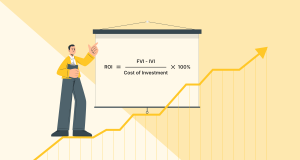Discounted Cash Flow (DCF) is one of the most widely used valuation techniques to estimate the intrinsic value of an investment, company, or project. It helps investors and analysts assess whether an asset is overvalued, undervalued, or fairly valued based on its expected future cash flows. This step-by-step guide explains how to construct a robust DCF model.
Understanding the Concept of DCF
A DCF model estimates the present value of expected future cash flows, discounted back to today using an appropriate discount rate. The formula for calculating DCF is:
Where:
- FCF: Free Cash Flow (the cash generated by the company that is available for distribution to investors).
- t: Time period.
- r: Discount rate (typically the Weighted Average Cost of Capital or WACC).
Why Use a DCF Model?
- It focuses on cash flow, which is a more reliable measure of financial health than accounting profits.
- It is based on the intrinsic value rather than market fluctuations.
- It is versatile and applicable to different industries and sectors.
Step 1: Understand the Business
Before building the model, you must understand the business or asset being valued. Consider:
- Revenue streams: What are the sources of income?
- Cost structure: What are the fixed and variable costs?
- Growth potential: What are the market trends and competitive advantages?
- Risks: What are the potential threats and challenges?
Understanding these factors will help you make realistic assumptions while constructing your model.
Step 2: Gather Financial Data
Collect historical financial data, typically from the company’s income statement, balance sheet, and cash flow statement. This includes:
- Revenue
- Operating expenses
- Depreciation and amortization
- Capital expenditures (CapEx)
- Changes in working capital
- Historical free cash flows
This data will serve as the foundation for projecting future cash flows.
Step 3: Project Free Cash Flows (FCFs)
A. Define the Forecast Period
Choose a reasonable forecast period, usually 5-10 years, depending on the industry and visibility of future performance.
B. Estimate Revenue Growth
Base revenue projections on historical trends, industry growth rates, and management’s guidance. Be realistic and consider:
- Market saturation
- Competition
- Economic conditions
C. Project Operating Expenses
Forecast operating expenses as a percentage of revenue or using specific cost drivers. Consider:
- Fixed costs: Rent, salaries, etc.
- Variable costs: Cost of goods sold (COGS), marketing expenses, etc.
D. Calculate Operating Profit (EBIT)
E. Adjust for Taxes
Account for taxes to estimate net operating profit after taxes (NOPAT):
F. Add Back Non-Cash Expenses
Add back depreciation and amortization since they are non-cash charges:
G. Account for Changes in Working Capital
Working capital changes represent the difference between current assets and current liabilities. Calculate:
H. Deduct Capital Expenditures (CapEx)
Subtract CapEx, as it represents cash outflows required for maintaining or expanding the asset base:
Repeat this process for each year in the forecast period.
Step 4: Determine the Discount Rate
The discount rate reflects the riskiness of the cash flows. For most companies, the Weighted Average Cost of Capital (WACC) is used:
Where:
- E: Market value of equity
- D: Market value of debt
- V: Total value (E + D)
- Re: Cost of equity (calculated using the Capital Asset Pricing Model or CAPM)
- Rd: Cost of debt
CAPM Formula:
Choose assumptions for the risk-free rate, beta, and market risk premium based on reliable data sources.
Step 5: Calculate the Terminal Value
Beyond the forecast period, cash flows are assumed to grow at a constant rate (the perpetual growth method) or based on an exit multiple (the exit multiple method). The perpetual growth method is more common:
Where:
- FCF_{n}: Free cash flow in the final forecast year
- g: Long-term growth rate (usually 2-3%, reflecting inflation and GDP growth)
- r: Discount rate
Step 6: Calculate the Present Value of Cash Flows
Discount each year’s free cash flow and the terminal value back to the present using the discount rate:
Where:
- n: Number of years in the forecast period
Step 7: Sum Up the Present Values
Add the present value of all forecasted cash flows and the terminal value to determine the enterprise value (EV):
Step 8: Adjust for Net Debt
To calculate the equity value, subtract net debt (total debt minus cash) from the enterprise value:
Divide the equity value by the total number of shares outstanding to calculate the intrinsic value per share:
Step 9: Perform Sensitivity Analysis
Discounted Cash Flow models are highly sensitive to assumptions about growth rates, discount rates, and terminal values. Conduct a sensitivity analysis to test different scenarios and their impact on valuation.
Common variables to adjust:
- Revenue growth rates
- Discount rates
- Terminal growth rates
Present results in a table or chart to show the range of potential outcomes.
Step 10: Interpret the Results
Compare the calculated intrinsic value with the current market price:
- Undervalued: If the intrinsic value is higher than the market price, the asset might be a good investment.
- Overvalued: If the intrinsic value is lower than the market price, the asset may be overpriced.
- Fairly Valued: If the intrinsic value is close to the market price, the asset is appropriately priced.
Key Considerations
- Accuracy of Assumptions: The model is only as good as its assumptions. Use credible data sources and realistic estimates.
- Dynamic Nature: Revisit and update the model periodically as new information becomes available.
- Limitations: While powerful, DCF is sensitive to input assumptions and may not capture external factors like market sentiment or unforeseen economic changes.
Conclusion
Building a Discounted Cash Flow (DCF) model is an essential skill in financial analysis, providing a comprehensive approach to valuing businesses or projects based on future cash flows. By following the steps outlined—projecting free cash flows, determining the appropriate discount rate, calculating the terminal value, and performing sensitivity analysis—you can create a robust DCF model that reflects the time value of money and various risk factors.
A well-constructed DCF model offers insights into a company’s intrinsic value, guiding investment and financial decisions. However, it’s important to remember that the accuracy of the model depends heavily on the assumptions made, such as cash flow projections, growth rates, and the discount rate. Therefore, sensitivity analysis plays a crucial role in understanding how changes in these assumptions impact the final valuation.



